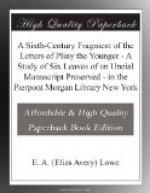There is only one case of possible emendation to note: 64, 29 questuri] {Pi} quaesturi MVa Aldus’s reading, as I learn from Professor Merrill, is in the anonymous edition ascribed to Roscius (Venice, 1492?), but not in any of the editions cited by Keil. This may be a conscious emendation, but it is just as possibly an error of hearing made by either Aldus or his compositor in repeating the word to himself as he wrote or set up the passage. Once in the text, quaesturi gives no offense, and is not corrected by Aldus in his edition of 1518. An apparently more certain effort at emendation is reported by Keil on 62, 13, where Aldus is said to differ from all the manuscripts and the editions in reading agere for facere. So he does in his second edition; but here he has facere with everybody else. The changes in the second edition are few and are largely confined to the correction of obvious misprints. There is no point in substituting agere for facere. I should attribute this innovation to a careless compositor, who tried to memorize too large a bit of text, rather than to an emending editor. At all events, it has no bearing on our immediate concern.
The striking similarity, therefore, between Aldus’s text and that of our fragment confirms our surmise that the latter may be a part of that ancient manuscript which he professes to have used in his edition. Whatever his procedure may have been, he has produced a text that differs from {Pi} only in certain spellings, in the correction, with the help of existing editions, of three obvious errors of {Pi} and of three of its readings that to Aldus might well have seemed erroneous, in two misprints, and in one reading which is possibly an emendation but which may just as well be another misprint. Thus the internal evidence of the text offers no contradiction of what the script and the history of the manuscript have suggested. I can not claim to have established an irrefutable conclusion, but the signs all point in one direction. I see enough evidence to warrant a working hypothesis, which we may use circumspectly as a clue, submit to further tests, and abandon in case these tests yield evidence with which it can not be reconciled.
[Sidenote: Editorial methods of Aldus]
Further, if we are justified in our assumption that Aldus used the manuscript of which {Pi} is a part, the fragment is instructive as to his editorial methods. If he proceeded elsewhere as carefully as here, he certainly did not perform his task with the high-handedness of the traditional humanistic editor; rather, he treated his ancient witness with respect, and abandoned it only when confronted with what seemed its obvious mistakes. I will revert to this matter at a later stage of the argument.
RELATION
OF THE MORGAN FRAGMENT
TO THE OTHER MANUSCRIPTS OF
THE LETTERS.
But, it will be asked, how do we know that Aldus used {Pi} rather than some other manuscript that had a very similar text and that happened to have gone through the same travels? To answer this question we must examine the relation of {Pi} to the other extant manuscripts in the light of what is known of the transmission of Pliny’s Letters in the Middle Ages. A convenient summary is given by Merrill on the basis of his abundant researches.[19]




